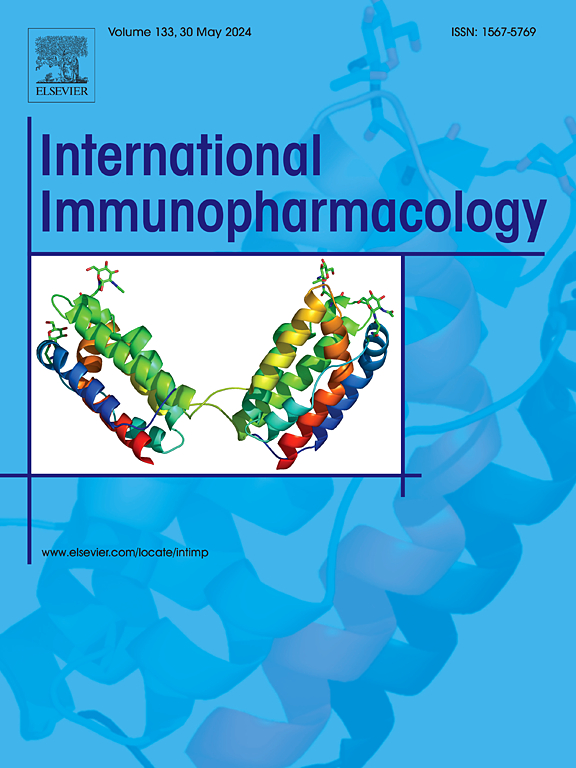Role of COL5A1 in lung squamous cell Carcinoma: Prognostic Implications and therapeutic potential
IF 4.8
2区 医学
Q2 IMMUNOLOGY
引用次数: 0
Abstract
Background
Lung squamous cell carcinoma (LUSC) is a significant health concern, characterized by a lack of specific therapies and limited treatment options for patients in advanced stages. This study aims to identify key molecules of prognostic importance in LUSC and provide an experimental foundation for their potential therapeutic applications.
Methods
Immune-related transcriptome expression analysis was performed on LUSC samples using the NanoString digital gene analysis system to develop a prognostic transcriptomic signature. This was followed by validation within the LUSC cohort database, and the immune properties and cellular functions of the critical molecule were examined through molecular biology experiments.
Results
Advanced nCounter analysis revealed significant differences in the numbers of T cells, cytotoxic cells, B cells, and CD45+ and CD8+ T cells between the OS1 (short-term survival) group and the OS2 (long-term survival) group. A comparison of the differences in tumor immune-related pathways between the two groups revealed that signaling pathways such as the PI3K-AKT, NF-kappaB signaling, Notch signaling, angiogenesis, matrix remodeling, and metastasis pathways were activated in the OS1 subgroup, and DNA damage repair and lymphatic chamber signaling pathways were activated in the OS2 subgroup. We analyzed and compared differentially expressed mRNAs with high expression levels in the OS1 and stage IV groups. Collagen type V alpha 1 (COL5A1) was found to be associated with the prognosis of LUSC. Phenotypic analysis revealed that COL5A1 knockdown inhibited the proliferation, migration, and invasion of SKMES1 cells. Locating COL5A1 was shown to be expressed in CAFs, T cells, and EPI cells through single-cell omics analysis.
Conclusion
COL5A1 plays a crucial role in tumor progression, indicating that COL5A1 inhibitors may represent a promising therapeutic strategy for the treatment of LUSC.
COL5A1在肺鳞癌中的作用:预后意义和治疗潜力。
背景:肺鳞状细胞癌(LUSC)是一个重要的健康问题,其特点是缺乏特异性治疗方法,晚期患者的治疗选择有限。本研究旨在确定在LUSC中具有预后重要性的关键分子,并为其潜在的治疗应用提供实验基础。方法:使用NanoString数字基因分析系统对LUSC样本进行免疫相关转录组表达分析,以建立预后转录组特征。随后在LUSC队列数据库中进行验证,并通过分子生物学实验检查关键分子的免疫特性和细胞功能。结果:高级nCounter分析显示,OS1(短期生存)组和OS2(长期生存)组在T细胞、细胞毒性细胞、B细胞、CD45+和CD8+ T细胞数量上存在显著差异。比较两组肿瘤免疫相关通路的差异发现,OS1亚组激活了PI3K-AKT、NF-kappaB、Notch、血管生成、基质重塑和转移等信号通路,OS2亚组激活了DNA损伤修复和淋巴室信号通路。我们分析并比较了OS1和IV期组中高表达的差异mrna。发现V α 1型胶原蛋白(COL5A1)与LUSC的预后相关。表型分析显示COL5A1敲低抑制SKMES1细胞的增殖、迁移和侵袭。通过单细胞组学分析发现COL5A1在CAFs、T细胞和EPI细胞中表达。结论:COL5A1在肿瘤进展中起着至关重要的作用,表明COL5A1抑制剂可能是治疗LUSC的一种有前景的治疗策略。
本文章由计算机程序翻译,如有差异,请以英文原文为准。
求助全文
约1分钟内获得全文
求助全文
来源期刊
CiteScore
8.40
自引率
3.60%
发文量
935
审稿时长
53 days
期刊介绍:
International Immunopharmacology is the primary vehicle for the publication of original research papers pertinent to the overlapping areas of immunology, pharmacology, cytokine biology, immunotherapy, immunopathology and immunotoxicology. Review articles that encompass these subjects are also welcome.
The subject material appropriate for submission includes:
• Clinical studies employing immunotherapy of any type including the use of: bacterial and chemical agents; thymic hormones, interferon, lymphokines, etc., in transplantation and diseases such as cancer, immunodeficiency, chronic infection and allergic, inflammatory or autoimmune disorders.
• Studies on the mechanisms of action of these agents for specific parameters of immune competence as well as the overall clinical state.
• Pre-clinical animal studies and in vitro studies on mechanisms of action with immunopotentiators, immunomodulators, immunoadjuvants and other pharmacological agents active on cells participating in immune or allergic responses.
• Pharmacological compounds, microbial products and toxicological agents that affect the lymphoid system, and their mechanisms of action.
• Agents that activate genes or modify transcription and translation within the immune response.
• Substances activated, generated, or released through immunologic or related pathways that are pharmacologically active.
• Production, function and regulation of cytokines and their receptors.
• Classical pharmacological studies on the effects of chemokines and bioactive factors released during immunological reactions.
文献相关原料
公司名称
产品信息
索莱宝
MTT solution
索莱宝
penicillin–streptomycin

 求助内容:
求助内容: 应助结果提醒方式:
应助结果提醒方式:


